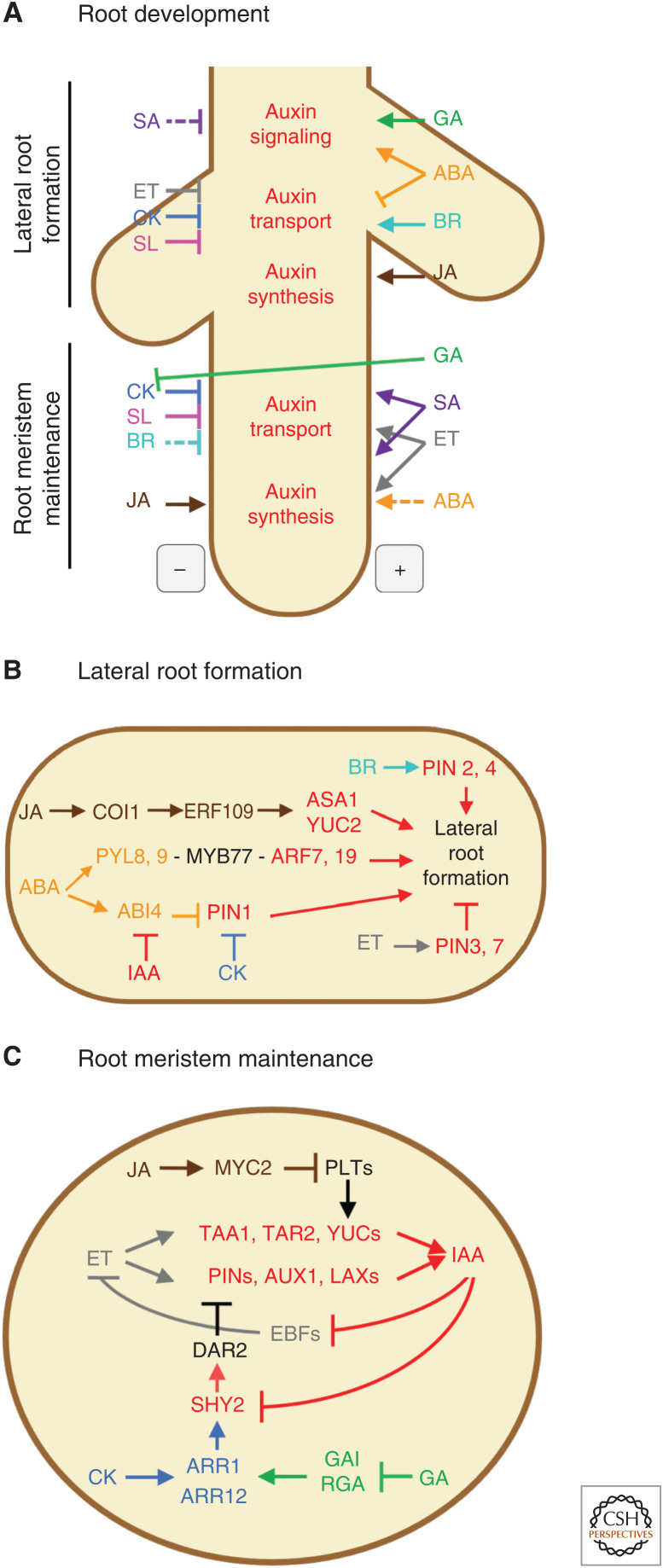Figure 2.
Auxin interactions with other hormones in roots. (A) Hormone interactions regulating auxin biosynthesis, transport, and signaling during lateral root (LR) formation and root meristem maintenance. The minus sign signifies repression of the root processes by the hormones listed on the left side of the root. The plus sign signifies promotion of the root processes by the hormones listed on the right side of the root. (B) Molecular network of the hormone interactions mediating LR formation. Abscisic acid (ABA) induces LR growth through PYL8. The interaction of PYL8, PYL9, with MYB77 promotes the crosstalk with the auxin signaling pathway via ARF7 and ARF19. ABA up-regulates the expression of ABI4, which represses the expression of PIN1 to modify auxin transport. The negative effect of this network on LR formation can be reinforced by the cytokinin (CK)-mediated repression of PIN1 or weakened by auxin-mediated inhibition of ABI4. Ethylene induces the expression of PIN3 and PIN7, which reduce the local accumulation of auxin in the LR initiation sites, and thereby decrease LR formation. Jasmonate (JA) boosts the formation of LRs by inducing the expression of ERF109, which promotes auxin biosynthesis by up-regulating the expression of ASA1 and YUC2. Brassinosteroid (BR) has a positive effect on the formation of LRs by inducing the expression of PIN2 and PIN4. (C) Molecular network of hormone interactions in root meristem maintenance. Ethylene (ET) induces auxin transport and biosynthesis, promoting the accumulation of auxin and enabling root meristem maintenance. Auxin dampens the negative effect of the EBFs on ET, reinforcing meristem function. CK and gibberellic acid (GA) have opposite effects on meristem maintenance by increasing and decreasing the activity of ARR1/ARR12 CK signaling components, respectively, which in turn represses the expression of PINs through SHY2 and DAR2. The JA-mediated repression of PLTs reduces the expression of the YUCs and lowers the production of auxin, thus negatively affecting root meristem maintenance. Arrowheads and blunt arrows represent positive and negative regulation, respectively. Solid and interrupted lines in panel A are used to depict direct and indirect effects, respectively. A dash between two proteins in panel B indicates direct physical interaction. Hormones, protein/genes in these hormonal pathways, and their actions are denoted by the following color pallet, ABA is orange, BR is turquoise, CK is blue, ET is gray, GA is green, IAA is red, JA is brown, salicylic acid (SA) is purple, and strigolactone (SL) is pink. Black is used to depict genes/proteins that do not belong to a specific hormone pathway, as well as the developmental processes the network regulates.

